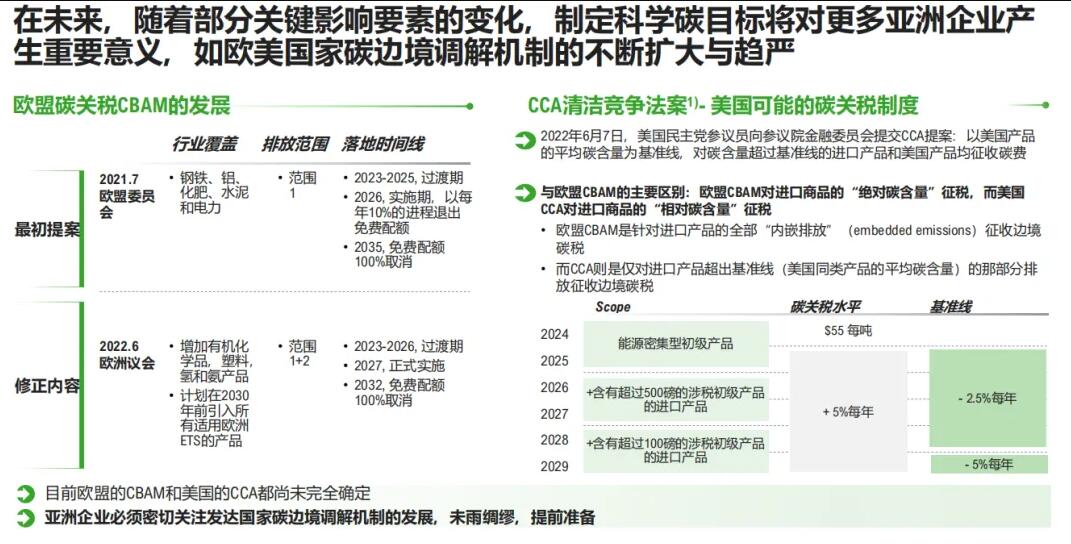It is expected that the importance of SBTi scientific carbon targets will continue to increase in the future, and the scope of influence will continue to expand
In the future, the development of scientific carbon targets will also be important for more Asian companies as some of the key influencing factors change, such as the expansion and tightening of carbon border regulation mechanisms in Europe and the United States, the development of domestic carbon policies in Asian countries, and the growing domestic c
This does not mean that other Asian companies should not be concerned about scientific carbon targets, and the increasingly urgent global climate change trend requires the active participation of all. In the future, the development of scientific carbon targets will also be important for more Asian companies as some of the key influencing factors change, such as the expansion and tightening of carbon border regulation mechanisms in Europe and the United States, the development of domestic carbon policies in Asian countries, and the growing domestic consumer awareness of sustainability linked to SBTi.
On 22 June 2022, the European Parliament adopted a regulation on the Carbon Border Adjustment Mechanism (“ CBAM”) Compared to the original European Commission proposal, although the European Parliament extended the transition period for CBAM to four years, it significantly shortened the decline period of free quotas to five years. In addition to the existing steel, aluminium, fertiliser, cement and electricity sectors, it has added organic chemicals, plastics, hydrogen and ammonia products, and plans to introduce all ETS products by 2030. The scope of emissions is also expanded from direct emissions (scope 1) to indirect emissions (scope 2).
Coincidentally, US Democratic Senator Whitehouse, together with three other Democratic senators, submitted a legislative proposal to establish a carbon border regulation mechanism to the Senate Finance Committee on June 7, called the Clean Competition Act. The design uses the average carbon content of U.S. products as a baseline, and imposes a carbon fee on imported and U.S. products that exceed that baseline. According to the proposal, the import carbon tax will initially target energy-intensive primary products, but from 2026 onwards, the product scope will begin to extend to downstream manufactured goods.
Although the current carbon border adjustment mechanism of European and American countries has not been fully determined, at the same time, due to the influence of the Russia-Ukraine war, their internal carbon neutral process has also suffered a certain setback, and many European countries have to restart coal power projects. But its commitment to a long-term transition to renewable energy will only grow stronger when energy security considerations are added. In the short term, the search for balance is likely to intensify pressure on developing countries, in the form of the aforementioned acceleration of carbon border regulation mechanisms. Regardless of whether they are already covered by existing proposals, Asian companies need to pay close attention to the process and prepare ahead of time.

Second, as domestic carbon policies mature and strengthen in Asian countries, there will be domestic pressure for companies to set scientific carbon targets. Taking the carbon market mechanism as an example, China is making every effort to build a national carbon market, and carbon prices will also increase as the mechanism matures, the free quota is gradually reduced, and the coverage is expanded. In South Korea, the most mature carbon market in Asia, carbon prices will rise by about 50% in 2021, narrowing the gap with European carbon prices. The carbon disclosure regime is another high-impact carbon policy that will provide an additional incentive for companies to set scientific carbon targets. From April 2022, listed companies on the first tier of Japan's stock exchange will be required to disclose climate change-related risks. Countries such as South Korea and India already have similar mandatory disclosure plans in place. In China, although the existing policy is still limited to encouraging companies to disclose carbon emissions information, the feasibility of mandatory disclosure policies is also being explored.
Finally, internal drivers from Asian consumers are also emerging. Many surveys have shown surprising results that consumers in some developing countries, such as China and India, have begun to show a stronger sense of sustainability than those in developed countries and are more willing to pay a premium for green products. However, this trend has not yet been linked to the SBTi Science-based carbon target, as the Science-based carbon target itself has yet to gain traction in Asia. In response to this situation, the SBTi launched the National Promotion Project in India in 2020, which effectively increased the local awareness of the SBTi. We believe that SBTi will continue similar outreach efforts to connect with the growing awareness of sustainability among Asian consumers.






 Consultation
Consultation
 400-115-9001
400-115-9001